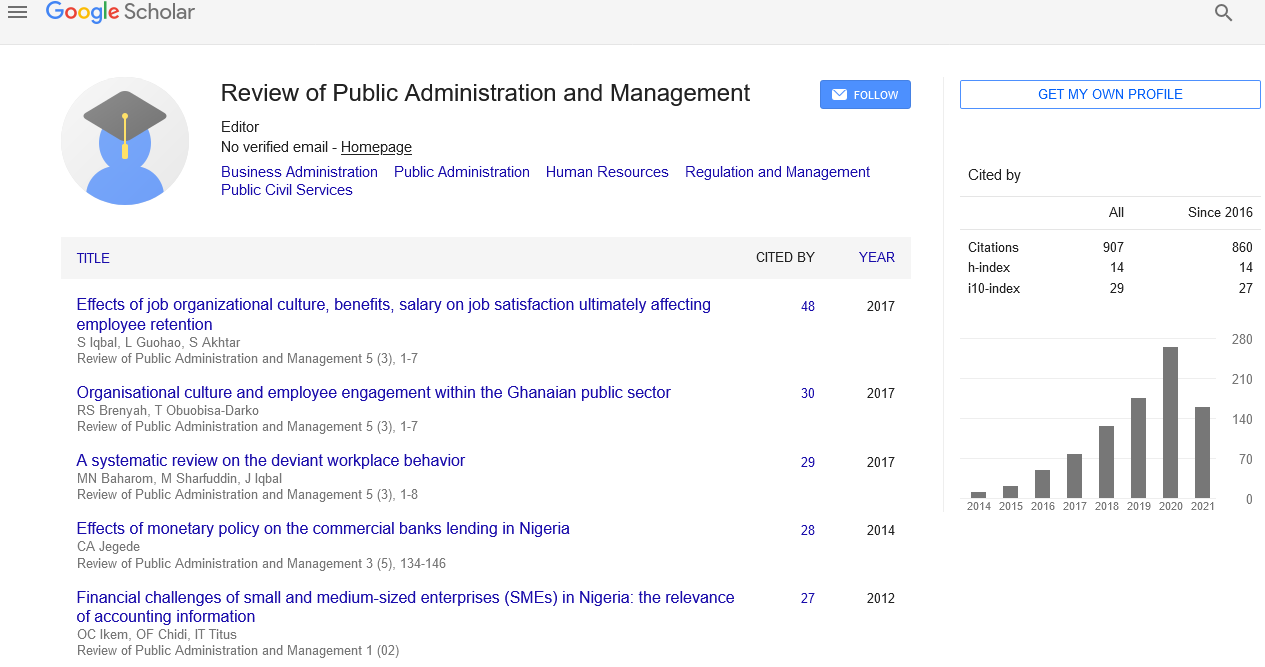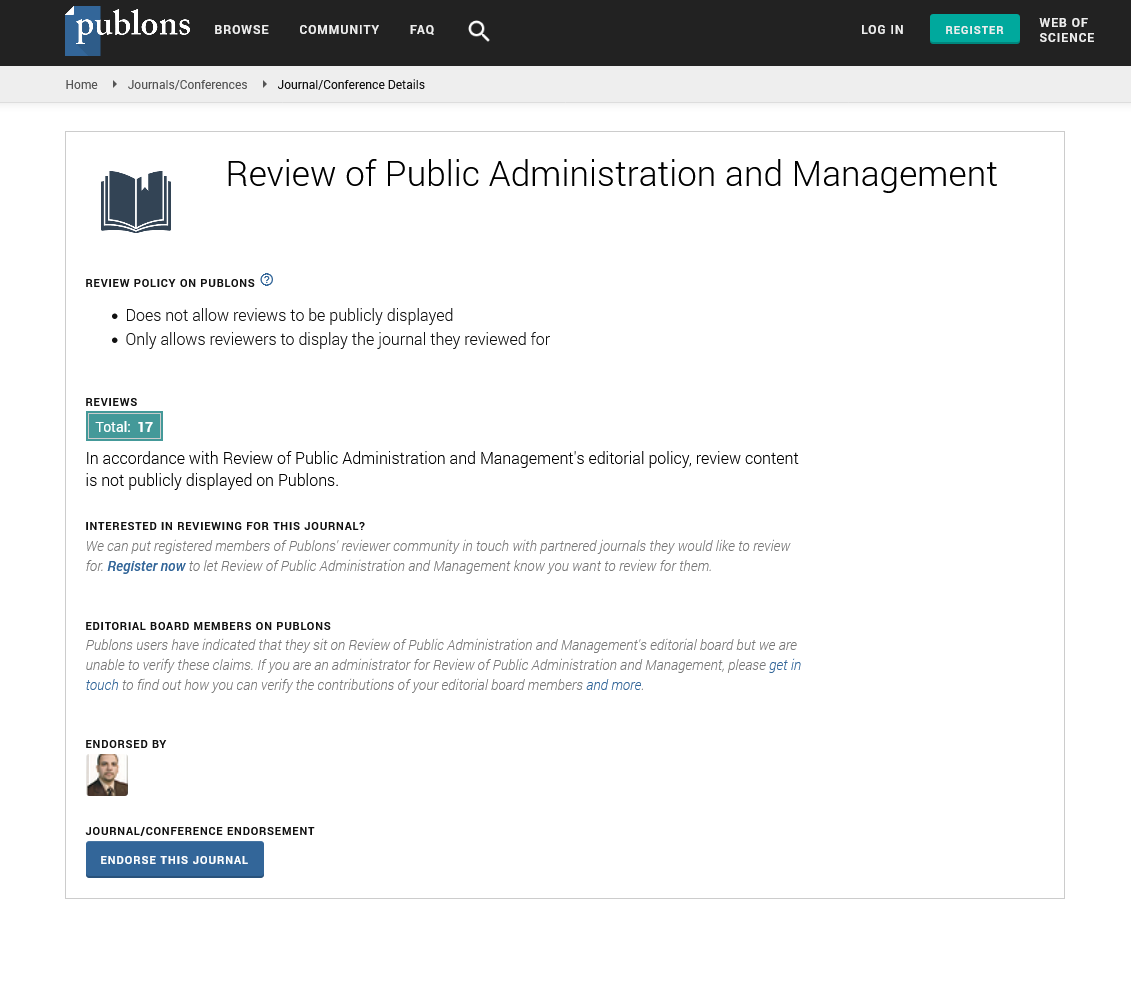Indexed In
- CiteFactor
- RefSeek
- Directory of Research Journal Indexing (DRJI)
- Hamdard University
- EBSCO A-Z
- Scholarsteer
- Publons
- Euro Pub
- Google Scholar
Useful Links
Share This Page
Journal Flyer

Open Access Journals
- Agri and Aquaculture
- Biochemistry
- Bioinformatics & Systems Biology
- Business & Management
- Chemistry
- Clinical Sciences
- Engineering
- Food & Nutrition
- General Science
- Genetics & Molecular Biology
- Immunology & Microbiology
- Medical Sciences
- Neuroscience & Psychology
- Nursing & Health Care
- Pharmaceutical Sciences
Research Article - (2017) Volume 5, Issue 1
Iraqs Public Administration Policies: An Overview
Abstract
Abstract The field of public administration has become over the course of the recent years, a very important one, being concerned primarily with political organizations, the definition of the implementation of government policy. It is centrally concerned with the organization of government policies and programmes, as well as with the officials in charge of the administrative systems. As for the geographical choice, Iraq was chosen particularly because it reflects the interest of the author, but also because its area of governance did not have yet the chance to be thoroughly studied. Another motivation for the choice resides with the fact that the waves of conflicts that took place in Iraq eventually modified the system to some extent, as well as the presence of the Islamic State in the area. The article is focused on the measures taken by the government in order to bring about the changes that are needed in Iraq, as well as providing a description of the projects that are implemented to fulfill the above-mentioned purposes. It was found that the projects influenced the system to some extent, but there are still more actions to be undertaken in order to bring the country to a stable line.
Keywords: Public administration; Policies; Reform projects
Introduction
The purpose of the present article is to provide an overview of the public administration in Iraq, in the context of the issues that arose at the level of government. An attempt of defining the current public administration of Iraq amid political and social chaos was made, relying on the available information.
Methodology and Research Questions
The method used to fulfill the scope of the present article is qualitative, being a longitudinal study, as an evaluation of the information available on the subject is performed. The data is provided in the form of words, as textual analysis is employed, in an attempt to collect information from the most accurate sources. The main question is how does the public administration system in Iraq actually work, being placed for the purpose of getting a deeper and broader perspective of the administrative mechanisms, along with policies and governmental structures, taking into consideration the state of instability currently marking the country.
Background on the Issue of Primary Focus
Iraq is a country located in the Middle East, bordering the Persian Gulf, between Iran and Kuwait. Its population is concentrated in the northern and eastern areas, as well as towards the center. Due to its strategic location on the waterway of Shatt al Arab, all the way to the head of the Persian Gulf, Iraq became a breeding ground for the birth of extremist regimes, as well making it prone to subsequent attacks.
The Ancient Mesopotamia (modern-day Iraq), also named the “Cradle of Civilization”, is the geographical area known to have one of the earliest recorded efforts to gather knowledge connected to public policy [1]. This occurred in today’s Basra area of Iraq. Moreover, in the ancient city of Ur, the first legal codes were produced in XXI Century BC, before Aristotle and Confucius.
Officially known as the Republic of Iraq, with the capital located in the city of Baghdad (33°20’N and 44°26’E), from a political point of view, as of today, the country is classified as a federal parliamentary republic. Its president is Mr. Fuad Masum, and the Prime Minister is Haydar al-Abadi. Iraq’s motto is known to be-Allah is the greatest- “Allahu Akbar”, meaning “God is the Greatest”. It is comprised of 18 governorates and one region.
Theoretical Aspects
Due to the fact that the country was affected by the endless rounds of conflicts, particularly because of the presence of IS (the Islamic State) in the Northern Region, the public administration of Iraq is very destabilized at the moment. At the level of managerial performance, Iraq represents a real problem, due to the inflated expenses and the slow pace of task fulfilment. Because of the wave of issues that are spread throughout Iraq at the level of public administration, there is a need for an adoption of policies that will have the power to re-activate the nongovernmental sectors, along with the one of transferring workforce surplus.
When it comes to theoretical aspects, it seems that the policies constructed and implemented for the purpose of creating a more functional government in Iraq do not seem to comply with the true nature of the country, as the outside states are not able to grasp the functions of the Islamic rule.
It is important to understand the fact that Iraq is a country that follows the traditional Shari’ah Law, as well as the rules of the Holy Qur’an. Moreover, with the coming of the Islamic State to power, a failed attempt of going back to the old law was made, resulting in political, social and economic disturbance. Among the most affected provinces were Nineveh (Ninawa), Kirkuk, Anbar and Bashra, due to the waves of conflicts and weapons used that placed the population at great danger.
Main Research
Since Iraq does not benefit from a stable system of public administration, or, to make it clearer, it basically lacks such a network, the policies implemented by the Tarabot-Iraq’s Administrative Reform Project were created for the scope of improving the administrative capacity of the Government of Iraq with the help of USAID (The United States Agency for International Development).
According to the USAID-Tarabot Iraq Administrative Reform Project-Annual Report from 2015, the public administration of Iraq fell into a crisis back in 2015, stemming from an acute shortage of resources, as the project focused on ways to help Iraq manage the latter. The project operated along with the Iraqi officials and Ministries, being focused on increasing oil revenues, improving public procurement and controlling government expenses.
The Public Procurement Reform (Reform of the public housing system) is among the most important moves made by the government, using international standard procurement systems for the purpose of supporting the project. The core of the process itself represents the aim of building confidence among the private sector in Iraq.
Tarabot is known to have assisted the ministries on the road of developing the strategic planning, along with the SOP (Standard Operating Procedures) for each of the units pertaining to the public policy arena. The project also has the necessary capability and influence to improve capital investment planning and implementation with the help of continuous capacity building in budgeting, procurement, as well as project oversight and management.
An Attempt to Define the Current Public Administration in Iraq
However, the path to stabilizing Iraq will not prove to be an easy task. According to Dawoody, continual turmoil, be it intentional or unintentional, eventually compromised Iraq’s performance as a complex, adaptive system [2].
It is no secret that Iraq is the true reflection of a political and social chaos. The crises, along with the changes in government and economic disturbances that profoundly marked the country are creating a state of disorder that is of no service to anyone pertaining to the described context. Moreover, the ousting of Saddam Hussein from power represented one of the biggest challenges that were faced by Iraq. From a personal point of view, the War in Iraq from 2003 eventually turned into a downward spiral for the society of the Middle Eastern country, taking into account the fact that the rule of Saddam Hussein knew a relatively stable line, when it comes to maintaining peace.
Surprisingly (or not), Iraq made significant efforts in adopting measures of good governance. For this purpose, according to al- Tamimi, an image of a technocratic government was constructed, being headed by highly-educated people, in an attempt made by the country to change the perception of the foreign states of it being an unwelcoming nation.
Results
The problems that are existent at the level of public administration in Iraq unfortunately are closely connected to all the social unbalance caused by the war, as, according to Dawoody, the lack of appreciation of Iraq’s culture and history was accompanied by an equally dismissive concern for its social harmony and national unity [3]. The proposals of dividing Iraq into parts and, eventually, the introduction of quota system within the public services, being based on ethnicity and religious affiliation, paints a dismal picture of the situation and the future of Iraq. Due to the constant focus on the ethnic and religious divisions that ended up consuming the country from the inside out, the Iraqi society is left with few options.
As for the public policy, the situation revolving around Iraq seems to take up the form of a blindfold. Some of the effective constitutional articles merely refer to public policy ownership of creation and implementation.
There has been a series of policies adopted by the Iraqi government, being considered important steps in the improvement of the public administration system. Among these one can mention the policies connected to the electricity issues, as well as to the high rates of school drop-out [4], that came to be considered as some of the most pressing problems of the country.
Another important issue to be taken into consideration represents corruption, arising because of nepotism, being more prevalent in less developed economies [5]. The countries in question are suffering from the outcomes of corruption, due to the absence of functioning government systems. Iraq is unfortunately a perfect example to fit the described case.
Some of the elements of the public policy making process in Iraq are: policy priority setting, preparations for policy proposals, along with legal drafts, intra-governmental consultations, submission to the office of the government, review that is conducted by the government office and by the ministerial committees, decisions made by the government, parliamentary processes and passage, policy implementation and evaluation. However, there are a series of subdivisions present, when it comes to the thematic issues involving: stakeholder consultation, strategic communication, policy making process based on evidence, administration and financial management of the policies, and the evaluation of the latter [6].
Although it is known that recommendations of the participants are also taken into consideration, especially in the Western countries, Iraq seems to construct a different scenario. According to the sources, Iraq lacks the elements that are crucial for any public policy making process, to be able to produce practical alternatives in order to address the most pressing public issues [7].
The main problem resides in the fact that the Iraqi people do not consult other stakeholders or counselors when it comes to policy making [8]. The severe individualism found in the Iraqi officials eventually proved to have a negative effect in the system of public administration and drafting of policies.
Conclusions
Iraq’s public administration is certainly marked by the waves of policies that influenced the society to a great extent. In addition to that, the continuous state of conflict, along with economic and social disturbance has to be taken into consideration, in order to be provided with a greater and more accurate perspective of the country’s reality. From a personal point of view, at least for the next decade, any intention of imposing a Western policy that disregards the Islamic way of thinking and action will not constitute a solution, yet will increase the potential for instability. Bottom line, it is absolutely impossible for the foreign states to intervene in Iraq without a thorough understanding of the Middle Eastern government. The changes imposed on the country, along with any attempt to “Westernize” the system, will only turn into a downward spiral for the society.
References
- William ND (2004) Public policy analysis: An introduction (3rdedn). Upper Saddle River, NJ: Pearson Prentice-Hall 44-55.
- Dawoody AR (2015) Public administration and policy in the Middle East, Civil society and democratic governance in Turkey: Prospects and challenges
- Central Intelligence Agency (2017) The World Fact Book, Middle East IRAQ
- Al-Bayan Center for Planning and Studies (2016) Aspects of Public Administration in Iraq Current Problems and Reform Proposals. Accessed on: March 31, 2017.
- USAID Iraq Tarabot
- United States Agency International Development USAID (2016) USAID-Tarabot IRAQ Administrative Reform Project Annual Report 2015. Accessed on: March 30, 2017.
- Management System Information (2017) Building Capacity: Strengthening Iraqi Public Policy and Civil Services.
- Tamimi Al A (2015) Perspectives on terrorism: The evolution in Islamic state administration: The documentary evidence 9.
Copyright: © 2017 Craciunescu CI. This is an open-access article distributed under the terms of the Creative Commons Attribution License, which permits unrestricted use, distribution, and reproduction in any medium, provided the original author and source are credited.


